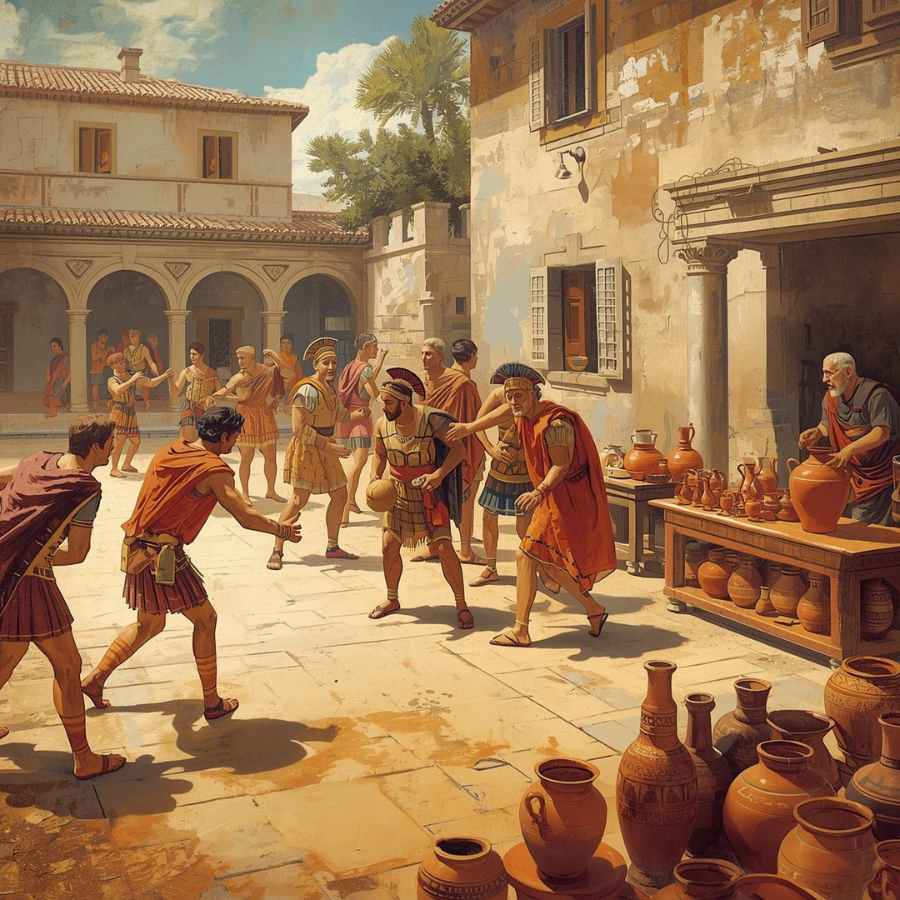Pigskin Dispatch’s Part 2 in the Series on American Football History
Rome adopts the Greek game.
This post follows PigskinDispatch.com’s opening football history lesson in the site’s article, “How American Football developed from the Ancient Ones.” The starting episode concluded with talking about the ancient Greeks playing a game called harpaston. History tells the tale of how another great Empire, Rome, eventually conquered the Greek civilization.
http://pigskindispatch.com/2025/10/22/how-american-football-developed-from-ancient-games
The Romans played a similar game, which they called harpastum. Harpastum was known as “the small ball game.” It had identical objectives to its Greek predecessor, but it used a ball of about the same size and hardness as a modern softball.
The Romans embraced the Greek game early on, but when Caesar Augustus took the throne a few decades before the birth of Christ, he found too much “gentleness” in it “for Roman youths destined to be centurions and commanders of legions.” He commissioned a “philosopher” to craft more rigid rules, and the new game was called “harpastum.” These new stricter rules were best described by the writer, Julius Pollux, who penned a description of the Roman game as played in the 2nd century: “At the two ends of the field, behind the line where the players are stationed, are two other lines, beyond which these two bands endeavor to carry the ball, a feat that cannot be accomplished without pushing one another backward and forward.”
Harpastum was known as the Small Ball Game because the other ball games played by the Romans had much larger balls. The Harpastum ball was made from a stitched leather skin and stuffed with chopped sponges or animal fur. The ball was approximately 8 inches in diameter. The number of players varied from game to game, with some reports suggesting games with hundreds of players on each side. Players had to get the ball over the opposing line to ‘score’. Harpastum was a high-speed and physical game. The game was also quite violent, as it allowed tackling. Because of the game’s nature, players only played Harpastum on grass or dirt since they expected to end up on the ground. Additional descriptions suggest teams drew a line in the dirt and endeavored to keep the ball behind their side of the line to prevent opponents from reaching it. It was inverted football because, instead of the team with the ball advancing it down the field, they were protecting it at all costs from their opponents, with the ball lying on the ground in what we can best describe as the offensive backfield.
Even Ancient Philosophers were fans of ancient football.
The ancient philosopher, Atheneaus, wrote this:
“Harpastum is the game I like most of all. Great is the exertion and fatigue attendant upon contests of ball-playing, and violent twisting and turning of the neck. He seized the ball and passed it to a team-mate while dodging another and laughing. He pushed it out of the way of another. Another fellow player he raised to his feet. All the while, the crowd resounded with shouts of Out of bounds, Too far, Right beside him, Over his head, On the ground, Up in the air, Too short, Pass it back in the scrum.”
The ancestors of the Romans in Italy brought the game to life once more, only they called it calcio. The Piazza della Novere of Florence is the cradle of this sport, which became known as giuoco del calcio fiorentino (“Florentin kick game”) or simply calcio (“kick”). The official rules of calcio were published for the first time in 1580 by a certain Giovanni Bardi.
Allegedly, another football root had evolved from an activity started during the Danish occupation of England (circa 787-1066 AD) when belligerent Anglo-Saxons kicked Viking skulls from village to village.
To conclude this part of our series on football history and its rough early beginnings, I will leave you with the following quotation from Sidonius, who wrote about 473 AD in France, where communities of Romans survived. He relates some marvelous details of their game of harpastum: “…Philomathius resolutely plunged into the ranks of the ball-players.” Daring, even he, to essay vigorously the toil of youths,” as the Mantuan poet (Virgil) has it. He had been a fine player, but that was when he was still relatively young. Now, the inside runner repeatedly pushed him from his place in the standing circle. Then, when he was brought inside the ring again, he failed to cut across or dodge the path of the ball as it flew close to his face or was flung over his head. He would often bend low in a flying tackle and then scarcely manage to recover from his staggering swerve. So he was the first to retire from the stress and strain of the game, puffing and blowing in a state of internal inflammation: indeed, his poor, swollen liver was sending frequent stabs of pain through his overtaxed body.”
Please read on in our part 3 installment titled, “British Influence on the Ancient Game.” Right here on your favorite website for football information, PigskinDispatch.com.


[…] The series will explore the Roman influence on American football in part 2 of Pigskin Dispatch’s journey through football history, titled “Roman Roots of the Gridiron Game.” […]
[…] Roman Roots of the Gridiron Game […]